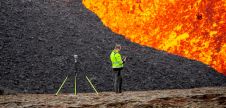Training the Future Geospatial Workforce
The coming years look promising for the geomatics sector, but the new generation of professionals must be prepared to face the challenges ahead. In view of the looming labour shortage in the surveying industry, is it time to take a fresh approach to training the future geospatial workforce?
测绘行业可以追溯到古老的蒂姆es and has played a transcendental role in the development of different civilizations. Early evidence of surveying practices and techniques can already be found in many historical documents in places such as Egypt, Greece or Rome. The evolution of the practice was relatively slow during the Middle Ages, until the arrival of the Italian Renaissance. This period of huge scientific and technological advancement laid the foundations for the surveying profession as we know it today. Since then, surveyors have been carving out a niche for themselves and creating new opportunities in the employment market by meeting the rising demands of construction and industry. After very little change for hundreds of years, the new tools and technologies that were introduced from the mid-20thcentury onwards enabled surveyors to work even more quickly and accurately. Yet while the equipment has evolved over time, the fundamentals have not actually changed that much throughout history.
In today’s internet era, however, the surveying profession is changing much faster than ever before due to the explosion of various global technologies (smartphones, IoT, big data, etc.) and the current accentuated value of location-based data. The profession has been rebranded as ‘geomatics’ as the skills offered by these specialists have diversified and moved ever further away from the classic concept of surveying. Geomatics practitioners are still able to generate geospatial information from measurements, as they always have done, but there is now a much wider range of measurement methods and data capture techniques. Therefore, they need to be constantly adapting their skills in this rapidly changing environment.
鼓励年轻人为地理学的未来
There is unprecedented demand for skilled manpower in geomatics, since geospatial information now plays a more essential role in society than ever. There are multiple and varied applications for geospatial skills and knowledge, with wide integration in urban and regional planning, natural resource monitoring, infrastructure management and precision agriculture, among others. In spite of this, there is currently considerable concern among businesses and academics involved in the geospatial field about the fact that job opportunities in the industry far outweigh the supply of qualified personnel.
Traditionally, due to the specificity and the relative complexity of the instrumentation used, the education and training in all geomatics-related fields would normally take place at universities. Perhaps surprisingly in view of the existing labour demand and the future prospects, an insufficient number of students are enrolling for geospatial-related university degrees almost everywhere. In fact, the lack of enthusiasm for land surveying, geodesy, GIS or geomatics programmes in some countries means that it is no longer feasible for university departments to continue offering them, which is creating a vicious circle. In that sense, perhaps it is time for the industry to increase its efforts to encourage youngsters to develop the knowledge and skills necessary for a future in geomatics at secondary school level, or maybe even earlier. Previous science, technology, engineering and mathematics (STEM) experiences promoted by universities have demonstrated that students who are exposed to field-specific activities at an early age are more interested in pursuing the subject later on.
Towards a Sufficient Supply of Skilled Geospatial Professionals
Paradoxically, given what seems to be happening within geomatics education itself, there is a clear increase in demand for geospatial courses and training activities from experts in other fields and even from a non-specialist audience. We are witnessing the democratization of many geospatial techniques, such as GIS and photogrammetry which are enjoying great popularity these days. The boom in high-tech devices such as drones and 3D printers is contributing to this and stirring up more fervour for mapping and recording geospatial data among the general public. In this context, many students and professionals from a wide range of fields are also considering strategies to enhance their portfolios and boost their credentials by acquiring new geospatial knowledge and skills.
在地理空间领域的这种日益增长的外部兴趣应被视为其吸引力的好兆头。为了利用这一机会吸引其他领域的新人才,也许是时候使地理空间培训计划现代化并为新学习者提供相关的工具和资源了。做到这一点的一种方法是开发不同程度的复杂程度,专门针对每种受众的培训活动。这可能是确保足够熟练和合格的地理空间专业人员满足行业未来需求的解决方案。

Make your inbox more interesting.Add some geo.
Keep abreast of news, developments and technological advancement in the geomatics industry.
Sign up for free
























